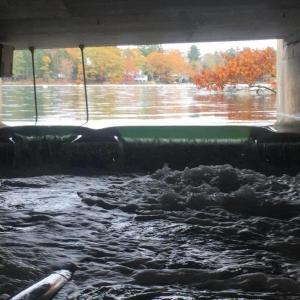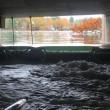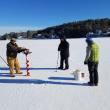Siphon improves West Harbor Pond’s water quality
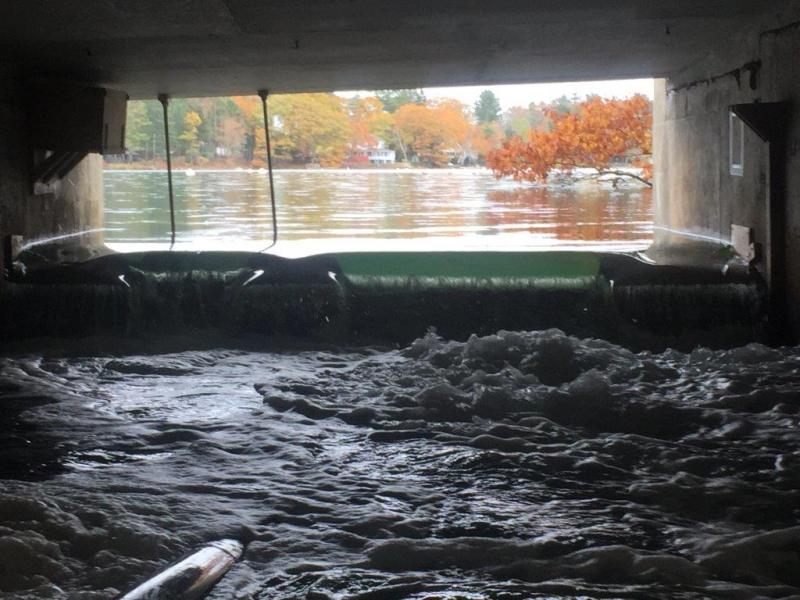 View through culvert showing saltwater from the harbor over-topping dam and entering the Pond, Oct. 16, 2020. Jason Bartlett photo
View through culvert showing saltwater from the harbor over-topping dam and entering the Pond, Oct. 16, 2020. Jason Bartlett photo
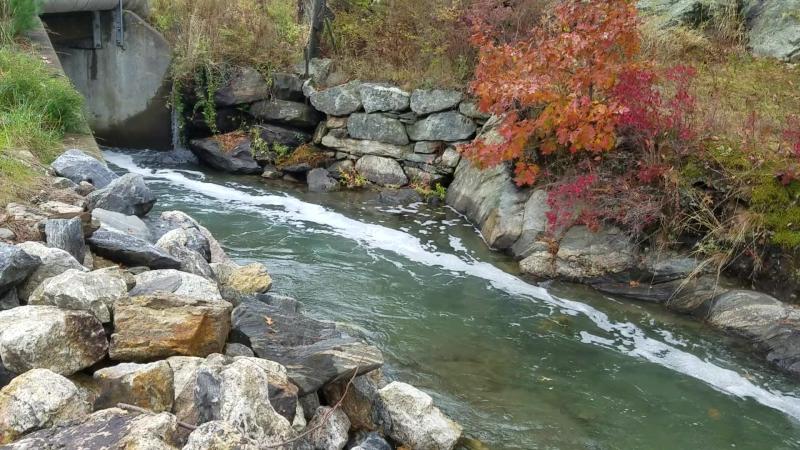 Current saltwater flowing through the culvert and into the Pond, Oct. 2, 2019. Merritt R. Blakeslee photo
Current saltwater flowing through the culvert and into the Pond, Oct. 2, 2019. Merritt R. Blakeslee photo
 David McFarland, Jon Dunsford and Leslie Volpe prepare to take water samples Feb. 9, 2018. Merritt R. Blakeslee photo
David McFarland, Jon Dunsford and Leslie Volpe prepare to take water samples Feb. 9, 2018. Merritt R. Blakeslee photo
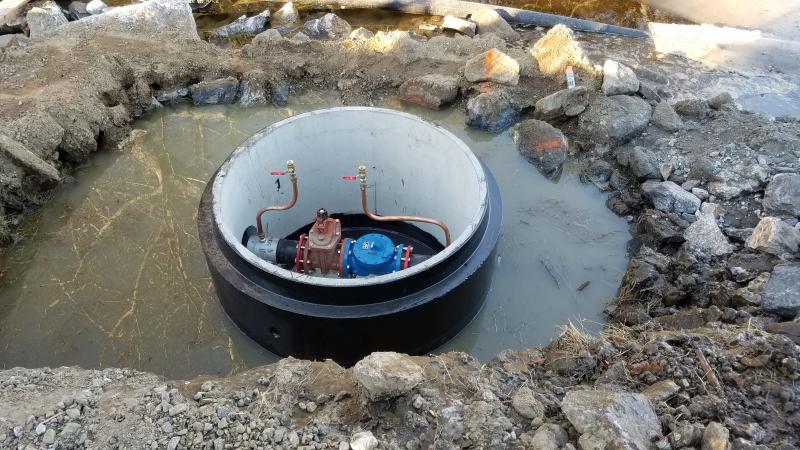 Manhole cylinder with siphon controls immediately after installation, Dec. 13, 2018. Merritt R. Blakeslee photo
Manhole cylinder with siphon controls immediately after installation, Dec. 13, 2018. Merritt R. Blakeslee photo
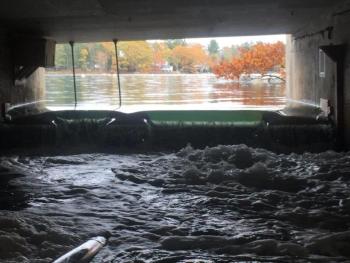 View through culvert showing saltwater from the harbor over-topping dam and entering the Pond, Oct. 16, 2020. Jason Bartlett photo
View through culvert showing saltwater from the harbor over-topping dam and entering the Pond, Oct. 16, 2020. Jason Bartlett photo
 Current saltwater flowing through the culvert and into the Pond, Oct. 2, 2019. Merritt R. Blakeslee photo
Current saltwater flowing through the culvert and into the Pond, Oct. 2, 2019. Merritt R. Blakeslee photo
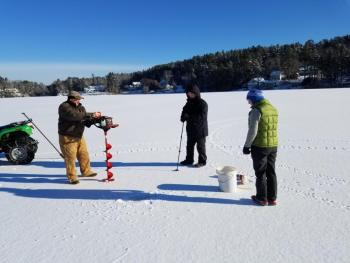 David McFarland, Jon Dunsford and Leslie Volpe prepare to take water samples Feb. 9, 2018. Merritt R. Blakeslee photo
David McFarland, Jon Dunsford and Leslie Volpe prepare to take water samples Feb. 9, 2018. Merritt R. Blakeslee photo
 Manhole cylinder with siphon controls immediately after installation, Dec. 13, 2018. Merritt R. Blakeslee photo
Manhole cylinder with siphon controls immediately after installation, Dec. 13, 2018. Merritt R. Blakeslee photo
Twenty-three months ago, on March 8, 2019, the new West Harbor Pond siphon was first placed in operation with the hope it would remedy the problems with the Pond’s water quality by reducing salinity and increasing oxygenation. By the end of 2020, the siphon had been operating continuously for ten of the previous thirteen months. It is now clear the siphon has fully achieved these goals.
Since 2013, WHPWA has regularly monitored the Pond’s water quality. Each month, the WHPWA’s testers measure and record temperature, dissolved oxygen, and salinity. The equipment used by the WHPWA for this testing is generously loaned by the Boothbay Harbor Sewer District, whose director, Chris Higgins, and board of trustees have provided invaluable support to the WHPWA’s water quality testing program.
Last month, WHPWA set about trying to interpret the dissolved oxygen and salinity data that they had been collecting. To do so, we enlisted the assistance of Sue Mello, Natural Resources Director, Boothbay Region Water District; Dr. Deborah Bronk, President and CEO, Bigelow Laboratory; and Linda Bacon, Lake Assessment Program, Maine Department of Environmental Protection, who helped us reach an accurate understanding of what the data show about the Pond’s water quality.
The recent data gathered by WHPWA’s water quality testing program make clear that the new siphon has improved the Pond’s water quality to a degree that surpasses even the highest hopes of WHPWA. These data show that the siphon 1) has eliminated the “rotten eggs” smell of hydrogen sulfide in the water discharged into the harbor, 2) has permitted seasonal turnover down to the 20-foot level, and 3) has increased the oxygenation and decreased the salinity of the Pond.
The siphon has eliminated the “rotten eggs” smell of hydrogen sulfide
When the replacement siphon began operating in March 2019, West Harbor Pond had not turned over (even partially) for several years, and a substantial reservoir of hydrogen-sulfide-laden water had accumulated in its lower depths. In the siphon’s first months of operation, the water that the siphon discharged into the inner harbor carried the distinctive rotten-eggs odor of hydrogen sulfide. Strong at first, this odor diminished over time. By May 2020, it had disappeared entirely. When the siphon was restarted on November 2020, after being turned off for three months, the odor did not return. In other words, while hydrogen sulfide, a natural by-product of plant decay, will continue to be produced in the bottom of the Pond, the siphon is now continuously draining the bottom of the Pond, such that the hydrogen-sulfide-laden water is removed before it can accumulate in sufficient quantities to produce an odor when the siphon discharges it into the inner harbor.
The siphon has substantially lowered the siphon has substantially lowered the salinity of the Pond
A prime determinant of a lake’s water quality is the oxygenation of the water column. When a lake experiences normal turnover in the spring and fall, the water column is reoxygenated. But differences in water density at different depths interfere with turnover and prevent re-oxygenation. And saltwater is denser than freshwater.
West Harbor Pond was originally a saltwater estuary of Boothbay Harbor, and king tides still bring twice-yearly injections of saltwater from the harbor. These king or perigean tides, which occur each spring and the fall, are the highest tides of the year. On the Pond, during these king tides, saltwater from the Boothbay Harbor side overtops the small dam in the culvert, allowing enormous volumes of saltwater to flood into the Pond. When it enters the Pond, the saltwater’s greater density carries it to the bottom, where its density differential has prevented the Pond from undergoing seasonal turnover since sometime after the old siphon failed in 2008.
The USGS defines “freshwater” as water containing less than 1 part per thousand (ppt) of dissolved solids, usually salt. Sea water like that in Boothbay Harbor has a salinity of about 35 ppt. When WHPWA began measuring salinity in early 2018, it found that the lower depths of the Pond typically had a salinity of from 10 to 12 ppt. Even at the surface, the salinity regularly exceeded 1 ppt. From June through October 2018, the salinity never fell below 1 ppt. Put differently, there was no water meeting the USGS definition of freshwater in the Pond during those months.
Restarting the siphon on Dec. 2, 2019 produced a sharp drop in the Pond’s salinity. By January 2020, the Pond was fresh to the 15-foot level and by April to the 17-foot level. Through September, the water remained fresh to the 14-foot level, even though the siphon was turned off on Aug. 29. In no previous year for which there are testing data had there been this much freshwater in the Pond. In October and November, the king tides returned and the salinity of the Pond soared. But restarting the siphon on Nov. 20, coupled with heavy fall rains, allowed the Pond to fill with freshwater to the unprecedented depth of 20 feet by Dec. 26, 2020.
The siphon has substantially increased the oxygenation of the Pond
The upper level of the Pond is generally well oxygenated, but the dissolved oxygen concentration falls off sharply in the lower depth of the Pond, which has not experienced regular seasonal turnover since sometime after 2008, when the 1880 siphon ceased operating. However, the data show that since the replacement siphon began continuous operation in December 2019, the increase in oxygenation has been impressive. Even in the months of 2020 when the oxygenation of the water column was lowest (January and February, immediately after the siphon resumed operation) exhibited better oxygenation than any month of 2018 or 2019. In April, and again in November and December 2020, the Pond contained no oxygen-depleted water down to the 25-foot level.
The siphon has permitted partial turn-over of the Pond
When the WHPWA conducted its last round of testing for 2020 on Dec. 26, 2020, the Pond was isothermal to the 20-foot level. Above this level, oxygenation was high and uniform. Even below this level, the water in the Pond’s Lower Basin (the southern end of the Pond) was highly oxygenated. In other words, it appears that the Lower Basin had experienced sufficient mixing to oxygenate the entire water column to the bottom of the Pond. In the Upper Basin, which is separated from the Lower Basin by a ridge that lies about 20 feet below the surface, the water column was highly oxygenated to the 20-foot level, below which oxygenation dropped sharply.
As to salinity, the last king tide occurred on Dec. 16, only ten days before the last testing of the year. In both the Upper and Lower Basins, the salinity of the water column to the 20-foot level was both uniform and low. Below that point, it rose to 6.2 ppt in the Lower Basin and to 12.2 ppt in the Upper Basin. Nevertheless, the year-over-year change is highly encouraging. In previous years, salinity of the Pond below 20 feet was twice that high.
Beginning at the 25-foot level, the Upper Basin retains a reservoir of highly salty water that so far seems unaffected by the actions of the siphon. This may be the effect of the ridge that separates the two basins, diminishing the siphon’s saltwater-removing action below the 20-foot top of the ridge.
Conclusions
As of December 2020, the replacement siphon has been responsible for a significant increase in oxygenation and decrease in salinity of West Harbor Pond to the 20-ft level. Below that level, the Upper Basin still contains a reservoir of highly saline and relatively deoxygenated water, although the oxygenation has improved dramatically in comparison with previous years. It also appears that the siphon is permitting turnover and mixing down to about the 20-ft level in both basins.
A detailed report with a description of these data will be posted on WHPWA’s website, westharborpond.org. We will place a notice in the Boothbay Register when the report is available for viewing.
Event Date
Address
United States

